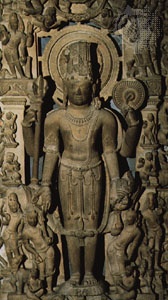Harihara
Hindu deity
also spelled Hari-hara
 in Hinduism, a syncretic deity combining the two major gods Vishnu (Hari) and Shiva (Hara). Images of Harihara (also known as Shambhu-Vishnu and Shankara-Narayana, variants of the names of the two gods) first appeared in the classical period after sectarian movements, which elevated one god as supreme over the others, had waned sufficiently for efforts at compromise to be attempted. The dual form found special favour in Cambodia, where inscriptions and images in the 6th–7th century are known. In images of Harihara, the right half is depicted as Shiva and the left as Vishnu. The visage of the Shiva half is awesome, befitting his function as destroyer, and its hands hold the trishula (“trident”); the Vishnu side is “pacific,” appropriate to the preserver role of that deity, and its hands hold weapons characteristic of him. Half the headdress is shown with Shiva's matted locks and half as Vishnu's crown, and on the forehead half of Shiva's third eye is visible. Many Hindus regard forms such as Harihara as aids in a process of spiritual growth whereby all representations of the divine are found to be partial and, if taken in isolation, misleading.
in Hinduism, a syncretic deity combining the two major gods Vishnu (Hari) and Shiva (Hara). Images of Harihara (also known as Shambhu-Vishnu and Shankara-Narayana, variants of the names of the two gods) first appeared in the classical period after sectarian movements, which elevated one god as supreme over the others, had waned sufficiently for efforts at compromise to be attempted. The dual form found special favour in Cambodia, where inscriptions and images in the 6th–7th century are known. In images of Harihara, the right half is depicted as Shiva and the left as Vishnu. The visage of the Shiva half is awesome, befitting his function as destroyer, and its hands hold the trishula (“trident”); the Vishnu side is “pacific,” appropriate to the preserver role of that deity, and its hands hold weapons characteristic of him. Half the headdress is shown with Shiva's matted locks and half as Vishnu's crown, and on the forehead half of Shiva's third eye is visible. Many Hindus regard forms such as Harihara as aids in a process of spiritual growth whereby all representations of the divine are found to be partial and, if taken in isolation, misleading.- collision theory
- Collis P. Huntington
- Collitz, Hermann
- Collodi, C.
- colloid
- Colloquy of Marburg
- Collot d'Herbois, Jean-Marie
- collotype
- Colluthus of Lycopolis
- Collège de France
- Colman, George, the Elder
- Colman, George, the Younger
- Colman, Norman Jay
- Colman Of Lindisfarne, Saint
- Colman, Ronald
- Colman, Samuel
- Colmar
- Colmar, baron von der Goltz
- Colmar Goltz, baron von der
- coloboma
- colobus
- colocynth
- Cologne
- cologne
- Cologne, University of